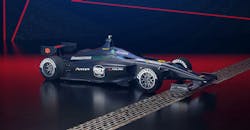Indy is embracing the world of autonomy with the world’s first head-to-head, high speed autonomous race at the famed Indianapolis Motor Speedway on October 23. And not only will future technology be on display – there is $1.5 million in prize money up for grabs.
Teams will program a modified Dallara IL-15 racecar to out-race and out-maneuver fellow innovators. Schaeffler, in partnership with Schaeffler Paravan Technologie GmbH & Co. KG, will provide its Space Drive system – including the necessary hardware, software, training and support – to all of the teams.
The Space Drive driving and steering system is a three-stage, multi-redundant motor driver and control system that will serve as the central control unit for converting the digital signals into actual driving signals on the road. This technology will be used equally throughout all of the teams’ race cars.“It is exciting to see all these universities coming together and team up with other universities to compete. The system we're providing is the arms and legs,” says Noel Marshall, senior account executive e-mobility with Schaeffler. “The sensors and the software sense in the world around it to serve as the eyes and ears that are talking to the arms and legs to make the vehicle do what it needs to be doing.”
Since there has never been an autonomous Indy-like vehicle, a lot of unknowns understandably exist. “We just don't know what we don't know,” she says. “We're having to go through a lot of simulation study of the hardware in the loop testing to make sure that once we do release these vehicles and these teams get the vehicle there won't be any accidents.”
With the potential of speeds nearing or exceeding 200 MPH, response time has to be very quick, explains Marshall. “Another challenge that the teams face is making sure the communication exists without significant delays. If they have to pivot or if there's a crash they have to go around, there's no time to think about it, the system has to know how to react,” she says.
Big picture autonomy
One of the first challenges within the autonomous space is the lack of rules, regulations and standardizations. “Nothing is standardized yet because we don't have the vehicle yet. There are a lot of gray areas as we design and deploy these vehicles, because the rules in place today aren't going to work for the vehicles of the future,” she says.
Of course, fixing this issue will most likely be a matter of iteration.“The other challenge is a lack of information or knowledge sharing with the broader community, or even outside the community. People who are not involved with the automotive industry or with autonomy, do not have a clear picture of really what it means to have an autonomous vehicle,” she says. “It is our duty to share this information, so people aren't afraid to adopt this new technology as safe."
Adds Marshall, "This collaborative project and the Indy race are just the beginning. If we pulled this off for an oval racetrack, the next step would be to do left and right hand turns and see how the vehicles perform.”
About the Author
Peter Fretty
Technology Editor
As a highly experienced journalist, Peter Fretty regularly covers advances in manufacturing, information technology, and software. He has written thousands of feature articles, cover stories, and white papers for an assortment of trade journals, business publications, and consumer magazines.


